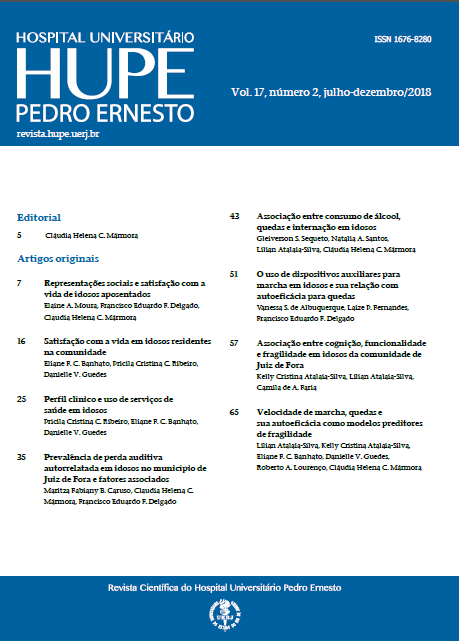Velocidade de marcha, quedas e sua autoeficácia como modelos preditores de fragilidade
DOI:
https://doi.org/10.12957/rhupe.2018.40862Resumo
Introdução: A fragilidade é uma síndrome que acomete idosos
mais vulneráveis, predispondo à incapacidade funcional e até
ao óbito. O objetivo do presente trabalho foi investigar se o
modelo composto por velocidade de marcha, número de quedas
e sua autoeficácia poderia explicar o desfecho fragilidade
em idosos. Materiais e Métodos: Foi realizado um estudo transversal
em uma amostra de idosos da comunidade da cidade
de Juiz de Fora (MG). Foram utilizados os instrumentos Falls
Efficacy Scale International (FES-I); cálculo da velocidade de
marcha e questionário sobre quedas. Resultados: A amostra foi
composta por 427 idosos, sendo 40 considerados frágeis pelo
fenótipo de fragilidade. O beta encontrado foi de 2,259 e todas
as variáveis foram estatisticamente significativas (p<0,001). O R
de Nagelkerke foi de 0,468, indicando que o modelo, composto
por velocidade de marcha, FES-I e número de quedas, explica
47% da variável dependente: fragilidade. Discussão: As variáveis
analisadas mostraram-se boas preditoras da síndrome da
fragilidade. Com base nesses dados, poderão ser desenvolvidos
modelos de diagnóstico e cuidado para o idoso frágil (detecção
precoce e tratamento) e para o idoso não frágil (prevenção primária)
com a utilização de instrumentos validados para o país,
considerando que ainda não existem trabalhos dessa natureza
e com essa abrangência na realidade brasileira. Conclusão:
Velocidade de marcha, número de quedas e FES-I parecem
ser preditores importantes do desfecho fragilidade em uma
amostra representativa de idosos comunitários.
Descritores: Fragilidade; Marcha; Cognição; Acidentes
por quedas.
Referências
Perracini MR, Ramos LR. Fatores associados a quedas em uma
coorte de idosos residentes na comunidade. Rev Saúde Pública.
;36(6):709-16.
Liu-Ambrose T, Davis JC, Nagamatsu LS, et al. Changes in
executive functions and self-efficacy are independently associated
with improved usual gait speed in older women. BioMed Central
Geriatrics. 2010;10(25):1-8.
El-khoury F, Cassou B, Charles MA, et al. The effect of fall
induced injuries in Community dwelling older adults: systematic
review and meta-analysis of randomised controlled trials. BMJ.
;347:f6234. doi: 10.1136/bmj.f6234.
Tinetti ME, Mendes de Leon CF, Doucette JT, et al. Fear of falling
and fall related efficacy in relationship to functioning among
community-living elders. J Gerontol. 1994 May;49(3):M140-7.
Reelick MF, Van Iersel MB, Kessels RP, et al. The influence of fear
of falling on gait and balance in older people. Age and Ageing.
;38:435-440.
Lachman ME, Howland J, Tennstedt S, et al. Fear of falling and
activity restriction: the survey of activities and fear of falling in the
elderly (SAFE). J Gerontol B Psychol Sci Soc Sci. 1998;53(1):P43-
Ferrucci L, Guralnik JM, Salive ME, et al. Effect of age and
severity of disability on short-term variation in walking speed:
the women’s health and aging study. J Clin Epidemiol.
;49(10):1089-96.
Liu-Ambrose T, Nagamatsu LS, Graf P, et al. Resistance Training
and executive functions: a 12-month randomised controlled
trial. Arch Intern Med. 2010;170(2):170-8. doi: 10.1001/
archinternmed.2009.494.
Friedman PJ, Richmond DE, Baskett JJ. A prospective trial of
serial gait speed as a measure of rehabilitation in the elderly. Age
and Ageing 1998;17:227-35.
Souza N, Mendes R, Silva A, et al. Combined exercise is more
effective than aerobic exercise in the improvement of fall risk
factors: a randomized controlled trial in community-dwelling older
men. Clinical Rehabilitation. 2017;31(4):478-486.
Verghese J, Mahoney J, Ambrose AF, et al. Effect of cognitive
remdiation on gait in sedentary seniors. Journal of Gerontology:
Medical Sciences 2010;65A(12):1338-1343.
Lourenço RA, Moreira VLG, Banhato EFC, et al. Prevalence
of frailty and associated factors in a community-dwelling older
people cohort living in Juiz de Fora, Minas Gerais, Brazil: Fibra-JF
Study. Ciênc Saúde Coletiva. 2019;24(1):35-44.
Camargos FF, Dias RC, Dias JM, et al. Cross-cultural adaptation
and evaluation of the psycho¬metric properties of the Falls
Efficacy Scale-Inter¬national Among Elderly Brazilians (FES-IBRAZIL).
Rev Bras Fisioter. 2010;14:237-43.
Liu-Ambrose T, Nagamatsu LS, Graf P, et al. Resistance Training
and executive functions: a 12-month randomised controlled
trial. Arch Intern Med. 2010;170(2):170-8. doi: 10.1001/
archinternmed.2009.494.
Fried LP, Tangen CM, Walston J, et al. Frailty in Older Adults: Evidence for a Phenotype. J Gerontol A Biol Sci Med Sci. 2001
Mar;56(3):M146-56.
Rockwood K, Howlett SE, MacKnight C, et al. Prevalence,
attributes, and outcomes of fitness and frailty in communitydwelling
older adults: report from the Canadian Study of
Health Study and Aging. J Gerontol A Biol Sci Med Sci. 2004
Dec;59(12):1310-7.
Boyd R, Stevens JA. Falls and fear of falling: burden, beliefs and
behaviours. Age and Ageing. 2009;38:423–428.
Yardley L, Beyer N, Hauer K, et al. Development and initial
validation of the Falls Efficacy Scale-International (FES-I). Age and
ageing. 2005;34:614-9.
Vellas BJ, Wayne SJ, Romeo LJ, et al. Fear of falling and
restriction of mobility in elderly fallers. Age and ageing.
;26:189-93.
Melo DM. Fragilidade, desempenho de atividades avançadas de
vida diária saúde percebida em idosos atendidos em ambulatório
de geriatria. Campinas. Dissertação [Mestrado em Gerontologia]
– Faculdade de Ciências Medicas da Universidade Estadual de
Campinas – UNICAMP; 2009.
Abreu SSE, Caldas, CP. Velocidade de marcha, equilíbrio e idade:
um estudo correlacional entre idosas praticantes e idosas não
praticantes de um programa de exercícios terapêuticos. Rev Bras
Fisioter. 2008;12(4):324-30.
Scheffer AC, Schuurmans J, Dijk NV, et al. Fear of falling:
measurement strategy, prevalence, risk factors and
consequences among older persons. Age Ageing. 2008;37(1):19-
doi: 10.1093/ageing/afm169. Review.
Wurzer B, Waters DL, Hale LA, et al. Long-term participation
in peer-led fall prevention classes predicts lower fall incidence.
Arch Phys Med Rehabil. 2014 Jun;95(6):1060-6. doi: 10.1016/j.
apmr.2014.01.018. Epub 2014 Feb 4.
Taylor D, Hale L, Schluter P, et al. Effectiveness of tai chi as a
community-based falls prevention intervention: a randomized
controlled trial. J Am Geriatr Soc. 2012 May;60(5):841-8. doi:
1111/j.1532-5415.2012.03928.x.
Granacher U, Muehlbauer T, Gollhofer A, et al. Evidencebased
and evidence-inspired: an intergenerational approach
in the promotion of balance and strength for fall prevention.
Gerontology. 2011;57(5):424-6. doi: 10.1159/000322149.


